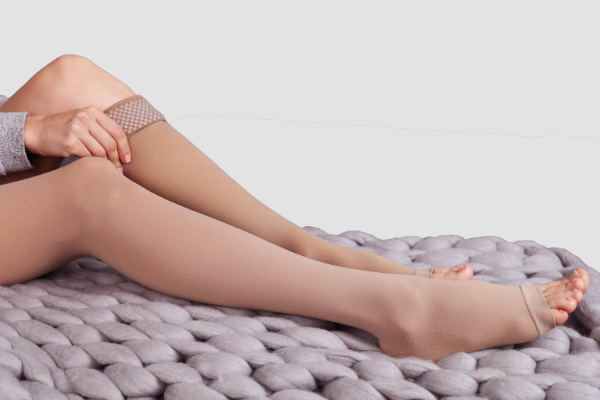Compression stockings, particularly knee-high compression socks for women, have become a popular solution for addressing various leg-related issues, such as swelling, discomfort, and venous insufficiency. These specialized garments apply pressure to the legs, promoting better blood circulation and reducing the risk of complications. However, the effectiveness of compression stockings for women is not solely determined by their design; the choice of materials plays a crucial role. In this comprehensive exploration, we will delve into the common materials used in making knee-high compression socks and how these materials impact their overall effectiveness.
Understanding Compression Stockings:
Compression stockings are designed to provide graduated compression, meaning the pressure is highest at the ankle and gradually decreases as it moves up the leg. This design helps push blood back up towards the heart, preventing blood from pooling in the veins. The benefits of compression stockings include alleviating symptoms associated with various conditions like deep vein thrombosis (DVT), varicose veins, and edema. To fully comprehend how materials affect the effectiveness of knee-high compression socks, it’s crucial to understand the properties of these materials and their impact on comfort, durability, and compression performance.
Common Materials Used in Knee-High Compression Socks:
Nylon:
Properties: Nylon is a synthetic material known for its durability and elasticity. It is often blended with other materials to enhance these properties.
Impact on Effectiveness: Nylon provides excellent durability, making compression stockings resistant to wear and tear. Its elasticity ensures a snug fit, contributing to consistent compression levels.
Spandex
Properties: Spandex is a stretchy synthetic fiber known for its exceptional elasticity. It is commonly blended with other materials to enhance flexibility.
Impact on Effectiveness: Spandex ensures that compression stockings retain their shape and provide a comfortable, form-fitting experience. Its elasticity contributes to the even distribution of pressure along the leg.
Microfiber:
Properties: Microfiber is a fine synthetic fiber designed for softness and breathability. It is often used to enhance the overall comfort of compression stockings.
Impact on Effectiveness: Microfiber promotes breathability, keeping the legs cool and preventing moisture buildup. This is crucial for individuals who need to wear compression stockings for extended periods.
Cotton:
Properties: Cotton is a natural fiber known for its softness and breathability. It is often blended with other materials to enhance comfort.
Impact on Effectiveness: Cotton contributes to the overall comfort of knee high compression socks. It absorbs moisture, keeping the skin dry and preventing irritation. However, cotton lacks the compression capabilities of synthetic fibers.
Silver-Infused Fabrics:
Properties: Some compression stockings incorporate silver-infused fabrics, known for their antimicrobial properties. Silver helps prevent bacterial and fungal growth.
Impact on Effectiveness: Silver-infused fabrics enhance hygiene, reducing the risk of skin infections. This is particularly beneficial for individuals with compromised skin integrity.
Natural Rubber:
Properties: Natural rubber, also known as latex, is a stretchy material with excellent elastic properties. It is often used in higher compression stockings.
Impact on Effectiveness: Natural rubber provides strong compression, making it suitable for individuals with more severe venous conditions. However, it may cause allergies in some individuals, necessitating alternatives for those with latex sensitivities.
Moisture-Wicking Fabrics:
Properties: Moisture-wicking fabrics are designed to pull moisture away from the skin, keeping it dry. These fabrics are often used in compression stockings to enhance comfort.
Impact on Effectiveness: By keeping the skin dry, moisture-wicking fabrics prevent chafing and irritation, ensuring that individuals can comfortably wear knee-high compression socks throughout the day.
Impact of Material Choices on Comfort:
The comfort of knee-high compression socks is a critical factor in determining their effectiveness. Uncomfortable stockings may discourage consistent wear, reducing their overall impact on managing venous conditions. The choice of materials significantly influences the comfort level of compression stockings.
Breathability:
Materials like microfiber and moisture-wicking fabrics contribute to breathability, allowing air circulation and preventing overheating. This is especially important for individuals who wear compression stockings for extended periods.
Softness:
Cotton and microfiber are known for their softness, providing a gentle touch against the skin. Soft materials enhance overall comfort, minimizing the risk of irritation or discomfort.
Elasticity:
Spandex and natural rubber provide the necessary elasticity for compression stockings to maintain their shape and provide a snug fit. This ensures that the stockings effectively apply the desired pressure to the legs.
Impact of Material Choices on Durability:
The durability of knee-high compression socks is crucial for their long-term effectiveness. Durable materials contribute to the longevity of the stockings, ensuring they maintain their compression properties over time.
Resistance to Wear and Tear:
Nylon is particularly known for its resistance to wear and tear. When blended with other materials, it enhances the overall durability of compression stockings, making them suitable for daily wear.
Shape Retention:
Spandex and natural rubber contribute to the shape retention of compression stockings. These materials prevent the stockings from sagging or losing their compression efficacy, even after multiple wears.
Impact of Material Choices on Compression Performance:
The primary purpose of knee-high compression socks is to provide graduated compression to promote blood circulation. The choice of materials significantly influences the compression performance of these stockings.
Consistent Pressure:
The elasticity of spandex and natural rubber ensures that compression stockings maintain consistent pressure levels along the leg. This is crucial for achieving the intended therapeutic effects.
Compression Gradience:
The design of compression stockings involves applying the highest pressure at the ankle and gradually decreasing it towards the top. Materials like spandex play a key role in achieving this gradual compression gradience, optimizing the therapeutic benefits.
Suitability for Different Compression Levels:
Natural rubber, with its strong elastic properties, is often used in higher compression stockings suitable for individuals with more severe venous conditions. The choice of material is tailored to the specific compression needs of the wearer.
Innovations in Compression Stocking Materials:
As technology and research advance, manufacturers are continually exploring innovative materials to enhance the effectiveness of compression stockings. Some recent developments include:
Copper-Infused Fabrics:
Copper-infused fabrics are being explored for their potential anti-inflammatory properties. While research is ongoing, these materials may offer additional benefits for individuals with conditions causing inflammation.
Graphene-Enhanced Materials:
Graphene, known for its excellent thermal conductivity, is being incorporated into compression stockings to regulate temperature. This can be particularly beneficial for individuals who experience temperature-related discomfort.
Biodegradable Materials:
Manufacturers are exploring eco-friendly, biodegradable materials for compression stockings. These materials aim to reduce the environmental impact of garment disposal while maintaining the necessary therapeutic properties.
Conclusion:
The effectiveness of knee-high compression socks for women is intricately tied to the materials used in their construction. Each material brings unique properties that impact comfort, durability, and compression performance. While synthetic fibers like nylon, spandex, and microfiber enhance durability and elasticity, natural fibers like cotton contribute to



